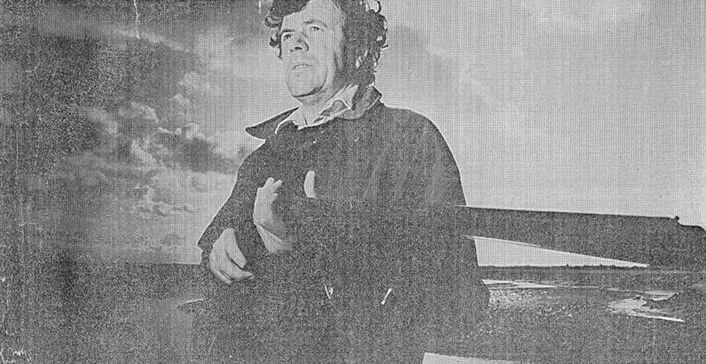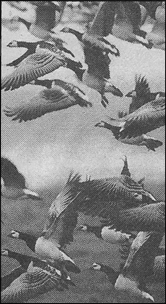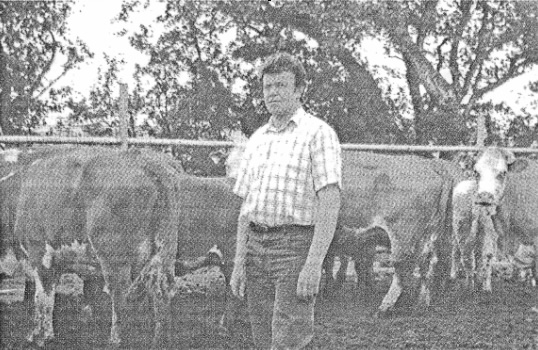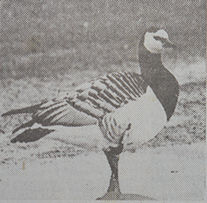 |
||||
| On patrol: Daniel Quinn says the only way to protect crops on his farm near Dumfries from wild geese is to leave the carcase of a bird in the field | ||||
Judge refuses to ban goose shooting |
||||
|
A JUDGE refused yesterday to ban a farmer from shooting wild geese on a nature reserve. |
This week the Wildfowl Trust had asked Lord Johnston to grant an interim interdict banning Mr Quinn from shooting the birds at Powhillon. The Court of Session heard that some 13,700 wild geese spend the winter in the Solway area before returning to the Artic to breed around April. |
|||
|
|
Refusing to grant an interdict, Lord Johnston said the case raised the extremely knotty problem of conflict between conservation and the interests of a farmer. |
prosecution, Lord Johnston warned him. |
||
|
John Robertson reports on a case that highlights the conflict between conservation and agriculture |
||||
Mr Reid added that under the lease covering Powhillon Farm, the trust, as landlords, had exclusive rights over the hunting, killing, and taking of game, which included the wild geese. The licence issued to Mr Quinn had been on condition that it was not taken as superseding any term of the lease. |
||||
Farmer who has a licence to kill |
|||
|
FEW of God’s creatures can be as heavily protected as the barnacle goose in southern Scotland. All 13,700 of those which breed on the Norwegian archipelago of Svalbard migrate each year to the Solway coast salt-marshes. It is a Site of Special Scientific Interest qualifying for designation under the Ramsar, Berne and Bonn conventions. |
think the geese were safe. Wrong. Enter Danny Quinn whose family has farmed at Powhillon on the northern edge of the reserve for over 60 years. To Quinn the geese are vermin. |
by Monro – are negotiating with Scottish farmers over the possible introduction of a compensation scheme. Quinn says the trust stood to make thousands of pounds a year. |
His house has a gaping crack in it. The trust’s sea wall has collapsed and half his land is flooded. “I will fight on.” He says, “even if it kills me.” |
Squabble as the geese fly |
||
|
ALMOST 200 years ago an eminent travel writer visited the hamlet of Powhillon on the coast of the Solway Firth and discovered "12 mud huts, with walls full of grooves and hollows". Powhillon is now a 280-acre farm, but some things never change: if you stand in the farmhouse and the farmer, Danny Quinn, stands in the stable, you can shake hands through a gaping "groove and hollow" in the structure. Powhillon is at the centre of one of Scotland's most intriguing land-use conflicts. The cracks are a symbol of the wrangle over the upkeep of a farm, which has been tenented by the family of Mr Quinn's wife since 1916. Equally symbolic are 145 permanently flooded acres, the fallen haysheds and 124 cattle which wade waist-deep in a quagmire which used to be pastureland. At the centre of the conflict are the 13,700 barnacle geese which migrate from their breeding ground in Spitzbergen to the Wildfowl and Wetlands Trust refuge at Caerlaverock. Mr Quinn farms just outside the reserve, but the voracious geese do not respect boundaries. The trust purchased Powhillon in 1975 in order to use it as a buffer zone in which illicit wildfowling could be controlled. Just before Christmas Mr Quinn made legal history when Dumfries Sheriff Court accepted that he had a valid defence for shooting protected barnacle geese: the protection of his livelihood from crop-loving birds. Locals now call him the "Lone Ranger", although he has promised to use his 12-bore sparingly. Buoyed by his success, he filed a sixth application to the Scottish Office Agriculture and Fisheries Division for a licence to shoot the species. On January 12, the Minister, Sir Hector Monro (Mr Quinn's MP), decided to grant the first licence to a farmer to shoot a Spitzbergen-bred barnacle goose. The trust failed to win an interim interdict at the Court of Session. Mr John Doherty, the centre manager at Caerlaverock, summed up the concerns of birdwatchers: "What this means in general terms is that there is no longer such a thing as a protected bird in Britain. "We are dismayed and astonished that the Secretary of State has granted a licence. Scottish Natural Heritage have been trying to negotiate an agreement with the farmer. Thousands of pounds would be paid to him to tolerate the geese. A compensation scheme exists on Islay, where farmers are paid £9.50 for every Greenland barnacle which dines on their acres. Mr Doherty says Mr Quinn was effectively offered £17 per goose in open court but he declined the offer as derisory. No other Solway farmer has had an offer of compensation, although some say they lose £15,000 every year. |
||
Andy Murray |
||
Ruffled feathers: Norway is considering protesting against a licence for a Scottish farmer to shoot protected barnacle geese |
||
 |
The trust has not repaired a seawall which prevents one of Europe's fastest tides from deluging the fields of Powhillon. Mr Quinn says: "We have been to hell and back. This whole thing must have cost me £50,000. The farm is ruined and there is no price to put on the heartache it has cost my family." Mr Doherty describes Mr Quinn's allegation that the trust is trying to drive his family out as "a serious accusation which we categorically deny". A negotiable programme for major investment in the farm involving tens of thousands of pounds has been on the table for years, he contends and Mr Quinn has rejected every proposal for a happy solution. The ultimate solution may be "divorce" in the Scottish Land Court, but Mr Quinn wants Scottish Secretary Ian Lang to act as an arbiter. "It is extremely worrying to the-trust that the property is being wrecked by the dispute," says Mr Doherty. Meanwhile, Scottish Natural Heritage (SNH) have been paying farmers to introduce merse grazing on the Solway, and they have issued gas guns to them to try to scare geese off their land. Mrs Marion Hughes, area manager of SNH, says they have offered Mr Quinn a management agreement to allow Powhillon to be included in their National Nature Reserve. He has not accepted it. "We are hoping to introduce a stewardship scheme on the merses," she said. "I cannot say whether a compensation scheme would be appropriate on the Solway, but it is one of the options being investigated." Mr Quinn's farming colleagues are holding on to their safety catches. But one of them, Mr Jim Brown, declared: "Scottish Natural Heritage say they are seriously looking at the crop damage. They are coming back in March. We will wait until then. If there is no compensation scheme on the way, then we will apply for licences like Danny Quinn. Norwegian ornithologists recently entered the fray by calling on their government to send an official protest to the Scottish Office. The Norwegian Ornithological Society claims the shooting of barnacle geese is unprecedented. They issued the following statement: This ready relaxation of the regulations for a local problem in Scotland may lead to the undoing of the international protection effort which has saved this population from extinction. |
|
| Solway's barnacle geese take off. | ||
|
Mr Doherty, a dedicated conservationist, looks upon the Spitzbergen geese as "a small and vulnerable population which were saved from extinction". There were only 400 of them after the Second World War, but there will probably be nearly 15,000 of them next winter an evironmental success story which inspired Dumfries and Galloway Regional Council and the area tourist board to adopt the species in their logos. The geese are still protected by the Wildlife and Countryside Act, by the EC Birds Directive, and by the Berne, Bonn and Ramsar conventions. They winter in a Special Protection Area and a Site of Special Scientific Interest. But the "Lone Ranger" is entitled to shoot a couple now and again if they descend upon his fields. Mr Doherty warns that Mr Quinns problem with geese and the long dispute over the maintenance of the farm are two separate issues. The Quinns sleep uneasily at night for fear that their house will eventually fall down. They have vowed to fight their landlords. The trust is on record saying it will not capitulate to unreasonable demands and it will not flinch from terminating the lease. |
||
 |
|
| Danny Quinn with some of the stock he was forced to sell | |
Protected geese put suckler herd's livelihood at risk |
|
|
from grazing damage by geese," he said. He also claimed his landlord failed to provide adequate buildings or fencing. That, coupled with damage caused by the geese, forced him to sell off his flock of 130 ewes in 1990. "Now I have had to reduce the sucklers there is no way I can make a living here."
|
|
| By Rog Wood | |
|
A DUMFRIES farmer is seeking compensation of £0.5m after overgrazing by geese forced him to cut his suckler herd from 124 cows to 40. |
|
| Anger as licence is issued to shoot protected geese | ||||
|
By Auslan Cramb THE Scottish Office has been accused of encouraging farmers to take the law into their own hands, after the issue of a licence to kill internationally protected barnacle geese. |
rhill |  |
rhill | This week, Scottish Natural Heritage (SNH), the Government environment agency, will attempt to defuse the row by offering farmers a one-year pilot scheme in which they would be paid compensation for putting up with geese on their land. Around 13,700 geese - the entire Spitsbergen population - now winter on the Solway. The figure has increased from under a few hundred in the 1950s. Several farmers are waiting to hear what is on offer from SNH before deciding on applications to the Scottish Office agriculture and fisheries department for licences to kill. Mr Quinn, however, has no plans to take up the cash offer. He claimed that the money being offered by the agency was insulting.Mr Quinn claimed he had been forced to reduce his herd of beef cattle because of the loss of grassland to the geese, which tear out plants by the root and compact the surface of the field. |
The barnacle goose: a visitor from the Artic |
||||
| lands Trust at Caerlaverock nature reserve. According to the trust, the licence was approved after Mr Quinn threatended to shoot the birds, whether he was granted a licence or not. The WWT director-general Dr Myrfyn Owen, said: "This decision could be read as a clear signal from the Scottish Office that it pays to take the law into your own hands. The licence has been granted, despite the fact that relatively small numbers of geese use this particular farm." |
||||